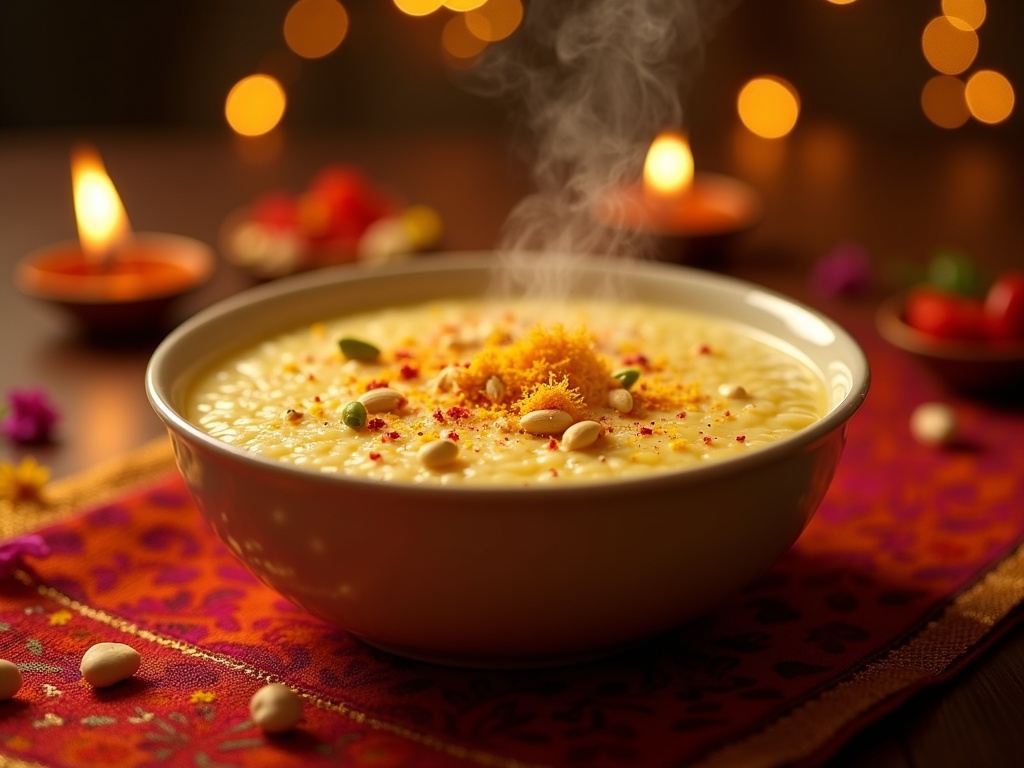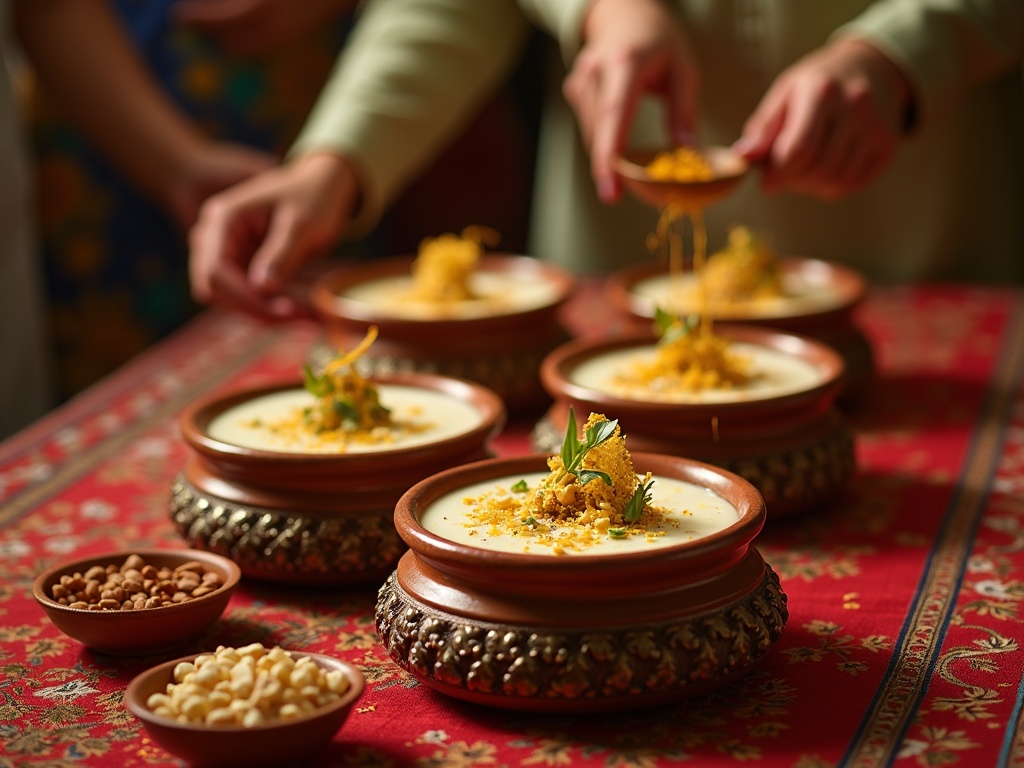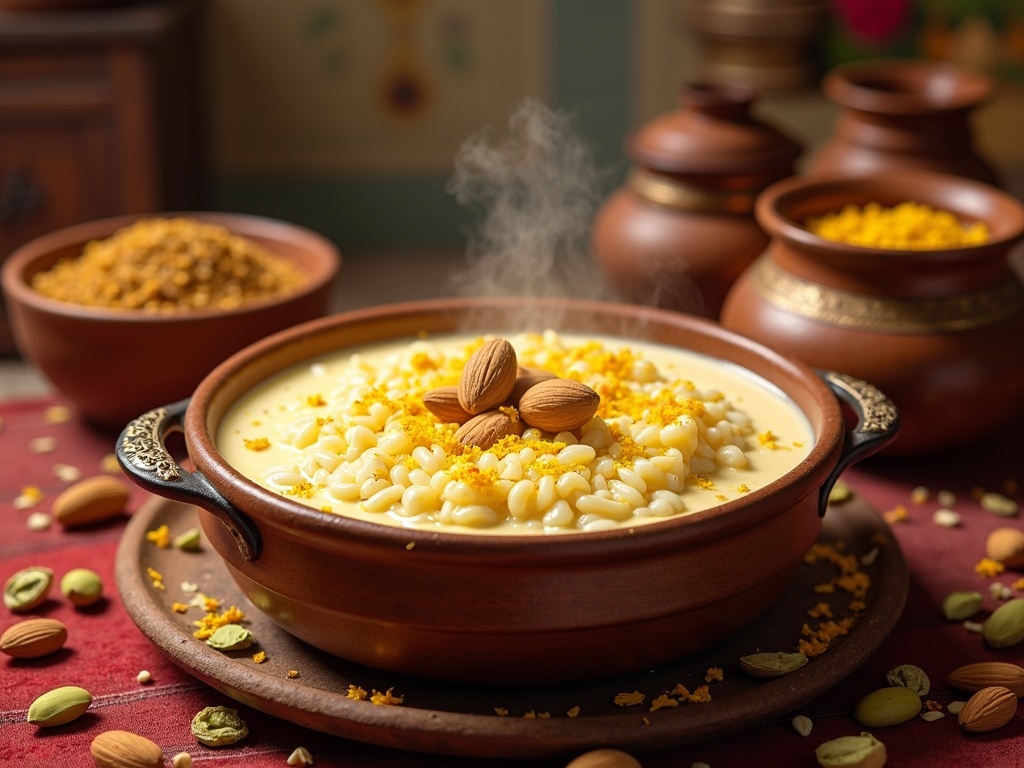The Kheer recipe is a beloved Indian rice pudding dessert that has graced celebration tables for centuries, becoming an essential part of festivals, weddings, and family gatherings across the subcontinent. This creamy, aromatic dessert combines simple ingredients like rice, milk, sugar, and cardamom to create a dish that connects generations through taste and tradition while crossing regional and religious boundaries.
Find In This Article
Key Takeaways
- Traditional kheer requires rice (usually Basmati), full-fat milk, sugar, cardamom, nuts, and sometimes saffron, simmered slowly to achieve its signature creamy consistency.
- The preparation process demands patience and constant stirring, typically taking 30-40 minutes of cooking time plus initial rice soaking.
- Kheer holds significant cultural importance as prasad (religious offering) and is central to festivals like Diwali, Raksha Bandhan, and Eid celebrations.
- Regional variations exist throughout South Asia, including vermicelli kheer (seviyan), versions with jaggery instead of sugar, and coconut-based adaptations.
- Modern adaptations include dairy-free alternatives, time-saving preparation methods, and creative presentations while still honoring the dessert’s rich heritage.
A Cherished Indian Dessert That’s More Than Just Pudding
Kheer holds a special place in Indian cuisine as one of the most beloved desserts across the subcontinent. This fragrant rice pudding has graced celebration tables for centuries, becoming an essential part of festivals, weddings, and family gatherings. I’ve found that kheer brings together simple ingredients to create something truly magical – a creamy, aromatic dessert that connects generations through taste and tradition.
The Cultural Significance of Kheer Recipe
In Hindu traditions, kheer serves an important religious purpose as prasad – a food offering made to deities before being distributed to devotees. The act of preparing and sharing kheer goes beyond mere culinary practice; it’s a spiritual experience that brings communities together. During major celebrations like Diwali (the Festival of Lights), families gather to prepare large batches of this traditional Indian dessert recipe to share with neighbors and loved ones.
The significance of kheer extends to other important celebrations as well. During Raksha Bandhan, a festival celebrating the bond between brothers and sisters, kheer is often prepared as a symbol of sweetness in relationships. In many Muslim households, particularly during Eid celebrations, a version of kheer known as seviyan (made with vermicelli instead of rice) becomes the centerpiece of festive meals.
What makes kheer truly special is its versatility across regional and religious boundaries. From the royal kitchens of Mughal emperors to humble village homes, kheer transcends social divisions and brings people together through a shared love of this delicious dessert tradition.
The traditional preparation of kheer involves a handful of key ingredients that come together in perfect harmony:
- Rice: Usually short-grain varieties that break down slightly during cooking
- Milk: Full-fat milk simmered slowly to reduce and thicken
- Sugar: Adjusted according to preference, though traditionally quite sweet
- Cardamom: The signature aromatic spice that gives kheer its distinctive flavor
- Nuts: Typically almonds, pistachios, and cashews for texture and visual appeal
- Saffron (optional): A few precious strands that impart a golden hue and subtle flavor
The preparation method itself is a lesson in patience. The rice must be cooked slowly in milk, allowing it to break down gradually while the milk reduces to a creamy consistency. This careful cooking technique can take anywhere from 45 minutes to over an hour, with constant stirring to prevent the milk from catching at the bottom of the pot.
Kheer’s appeal lies partly in its adaptability. Northern regions might add rose water for fragrance, while southern variations (sometimes called payasam) might incorporate jaggery instead of white sugar. In Bengal, you’ll find versions made with date palm jaggery called nolen gurer payesh, while coastal regions might create coconut-based variations that reflect local ingredients.
The dish can be served either warm or chilled, depending on the season and occasion. During winter festivals, warm kheer provides comfort, while summer celebrations call for kheer served cold, sometimes with additional garnishes of rose petals or silver leaf (vark) for special occasions.
I’ve found that making kheer at home connects me to centuries of tradition while still allowing for personal expression through subtle variations in spicing and garnishes. Whether you’re celebrating a special occasion or simply craving something sweet, this timeless dessert recipe offers both comfort and luxury in every spoonful.

Essential Ingredients for Perfect Kheer Recipe
Creating authentic kheer requires a handful of simple ingredients that come together to create a luxurious dessert. I’ve found that the quality of these components makes all the difference between an ordinary rice pudding and a memorable kheer that leaves everyone asking for seconds.
Core Ingredients
The foundation of any good kheer starts with high-quality Basmati rice. This long-grain variety adds a distinctive fragrance and texture that can’t be matched by regular rice. For the perfect kheer, you’ll need:
- 1 cup Basmati rice (rinsed thoroughly until water runs clear)
- 4 cups full-fat milk (never substitute with low-fat versions)
- 3/4 cup sugar (adjust according to taste)
- 1 teaspoon cardamom powder (freshly ground works best)
- 1/2 cup mixed nuts like cashews and almonds (chopped or sliced)
- 10-15 saffron strands for that golden color and subtle flavor
- Raisins and fresh fruits as optional garnishes
The rinsing process is crucial for achieving that perfect creamy consistency. I always rinse my rice at least 3-4 times or until the water runs completely clear. This removes excess starch and prevents the kheer from becoming too gluey or thick.
Full-fat milk is non-negotiable for traditional kheer. It creates that signature rich texture that’s impossible to achieve with reduced-fat alternatives. The slow simmering of full-fat milk produces a naturally sweet, caramelized flavor that forms the backbone of this delicious Indian dessert recipe.
Flavorings and Garnishes
Cardamom is the signature spice in kheer, giving it that distinctive aromatic quality. Freshly ground cardamom powder makes a noticeable difference compared to pre-packaged versions. If you have the time, crack open cardamom pods and grind the seeds just before cooking.
Saffron brings both color and subtle flavor to your kheer. For best results, I crush the saffron strands between my fingers and soak them in a tablespoon of warm milk for 10-15 minutes before adding to the main mixture. This helps release the color and flavor more effectively.
The nuts provide a delightful textural contrast to the creamy pudding. For an enhanced taste, lightly toast cashews and almonds before adding them to your rice-based dessert. This simple step brings out their natural oils and intensifies their flavor.
While traditional kheer relies on these basic ingredients, there’s room for personal touches. Some regions add raisins for bursts of sweetness, while others incorporate seasonal fruits like mangoes or bananas. During special occasions, I sometimes add a teaspoon of rose water or a pinch of nutmeg for an elevated flavor profile.
Sugar can be substituted with jaggery or palm sugar for a more complex sweetness with caramel undertones. These alternatives complement the homemade dessert beautifully and add depth to the flavor profile.
The beauty of kheer lies in its simplicity. With just these few quality ingredients, you can create a dessert that’s been cherished across South Asian cultures for centuries. Whether served warm on a cool evening or chilled during summer months, kheer made with these essential components never fails to satisfy.

Making Traditional Kheer Recipe Step by Step
I’ve prepared kheer for countless family gatherings, and the secret to perfect results lies in following a methodical approach. This traditional South Asian rice pudding requires patience but rewards you with a fragrant, creamy dessert that’s absolutely worth the effort.
Essential Preparation and Cooking Process
Before starting my kheer, I always soak the rice for at least 30 minutes. This crucial step softens the grains and helps them absorb the milk better, creating that signature velvety texture that traditional dessert recipes are known for.
Once the rice is soaking, I pour milk into a large, heavy-bottomed pot and bring it to a boil. This part demands attention – I stir continuously to prevent the milk from sticking to the bottom or forming an unwanted skin on top.
When the milk reaches a rolling boil, I add the drained, soaked rice and immediately reduce the heat to a gentle simmer. This temperature control is critical for developing the pudding’s texture. The mixture needs to cook for 20-25 minutes until the rice becomes completely tender. During this time, I don’t stop stirring, especially around the edges of the pot where burning happens most often.
The magic happens in the final stages when I add:
- Sugar to taste (usually about ¼ cup per liter of milk)
- Freshly ground cardamom for that distinctive aroma
- A few strands of saffron soaked in warm milk for color and flavor
- Chopped nuts like almonds and pistachios for crunch and richness
These flavoring ingredients need about 5 more minutes of gentle cooking to infuse properly. The entire traditional preparation typically takes 30-40 minutes, not counting the initial rice soaking time. Many Indian rice dishes require similar patience, but kheer stands out for its sweet, aromatic profile.
I can’t emphasize enough how important continuous stirring is throughout the process. Not only does it prevent the milk from burning, but it also breaks down some of the rice starch, creating that signature creamy consistency that makes homemade desserts so satisfying.
The kheer will continue to thicken as it cools, so I often remove it from heat when it’s slightly thinner than my desired final consistency. For serving, I transfer it to individual bowls or a large serving dish and garnish with additional nuts, sometimes a sprinkle of rose petals, or even a light dusting of cinnamon.
What makes this dessert so special is its adaptability. While maintaining the core technique, I can adjust the sweetness, thickness, and flavoring based on regional preferences. Southern variations might include coconut milk, while northern styles might feature more nuts or dried fruits. Some families even pass down special dessert techniques through generations.
For a richer version, I sometimes substitute part of the regular milk with condensed milk or cream, though this moves away from the more traditional preparation. On busy days, I’ve successfully made kheer in a pressure cooker or slow cooker, though the stovetop method gives me the best control over the final texture.
Serving Your Kheer
Once I’ve prepared a perfect bowl of kheer, the presentation is just as important as the recipe itself. This creamy, aromatic dessert deserves to be showcased in a way that highlights its rich heritage and delightful flavors. The serving process adds a final touch that can transform this simple dessert into a showstopping finale for any meal.
Presentation Ideas
I always serve kheer in decorative bowls to enhance the visual appeal. Traditional clay pots called ‘mitti ke bartan’ add an authentic touch, while crystal serving dishes create an elegant display for special occasions. The contrast between the creamy white pudding and a colorful vessel makes for a stunning presentation.
Garnishing elevates kheer from delicious to extraordinary. I like to sprinkle these toppings just before serving:
- Finely chopped pistachios for a pop of green
- Almond slivers that add satisfying crunch
- A pinch of saffron strands for vibrant color
- Edible silver or gold leaf (vark) for festive occasions
- A light dusting of cardamom powder for aromatic finish
Temperature plays a crucial role in serving kheer. During summer months, I chill it thoroughly for a refreshing dessert experience. In winter, I often serve it warm with a drizzle of aromatic rose water for added comfort. Both versions highlight different aspects of this versatile dessert.
For a contemporary twist, I sometimes pair kheer with a small scoop of vanilla ice cream. This fusion approach creates an interesting temperature contrast and appeals to those who enjoy creamy dessert combinations. The cold ice cream against the traditional kheer creates a delightful sensory experience that guests rarely expect but always enjoy.
Social and Cultural Significance
Kheer holds special importance during festive celebrations and family gatherings. I often prepare large batches for Eid, Diwali, or wedding ceremonies where it’s traditionally served as a blessing. The communal aspect of sharing this sweet dish symbolizes prosperity and joy in many South Asian cultures.
The preparation of kheer can also become a meaningful group activity. I’ve found that cooking kheer together creates wonderful bonding moments in the kitchen. Children can help with simpler tasks like rinsing rice or adding raisins, while elders share family stories and cooking techniques passed down through generations.
I like setting up a small kheer station during parties where guests can customize their servings with different toppings. This interactive approach adds a fun element to dessert time and accommodates varying preferences. Some guests prefer extra nuts while others might enjoy their kheer with fresh fruit additions.
Leftover kheer makes an excellent breakfast treat the next morning. I find the flavors develop beautifully overnight, creating an even more complex taste profile. Served alongside morning tea, it transforms into a decadent start to the day that feels both indulgent and connected to sweet culinary traditions.
When hosting international guests, I serve smaller portions of kheer as an introduction to South Asian desserts. Its familiar rice pudding format makes it accessible, while the cardamom and saffron flavors offer a distinctly exotic experience. I’ve converted many skeptics into kheer enthusiasts with this approach to cultural food sharing.

Modern Adaptations and Nutrition
I’ve discovered that kheer, while incredibly delicious, can be adapted to fit various dietary needs without sacrificing its core appeal. A typical serving of traditional rice kheer (about 1/2 cup) contains approximately 200 calories, making it a moderate indulgence that can fit into most balanced diets when enjoyed occasionally.
The nutritional breakdown reveals kheer offers 3g of protein, 30g of carbohydrates, and 6g of fat per serving. The protein content comes primarily from the milk, while the carbs derive from both the rice and sugar. The fat content varies based on whether you use whole milk, reduced-fat milk, or a non-dairy alternative.
Creative Variations
Beyond the classic rice kheer, several delicious variations have gained popularity:
- Vermicelli kheer (also called seviyan kheer) substitutes thin vermicelli noodles for rice, creating a different texture while maintaining the creamy essence of traditional kheer.
- Semiya kheer, similar to vermicelli kheer but often prepared with slightly thicker noodles.
- Fruit-infused versions incorporating mangoes, bananas, or apples for added natural sweetness.
- Nut-enhanced kheer with pistachios, almonds, or cashews for extra crunch and nutritional benefits.
For those with dietary restrictions, I’ve found plant-based alternatives work surprisingly well. Coconut milk kheer delivers a tropical twist while addressing dairy allergies. Almond milk creates a lighter version with a subtle nutty flavor that complements the traditional cardamom beautifully.
Time-Saving Innovations
The busy modern lifestyle has led to time-saving adaptations of this beloved dessert. Instant kheer mixes have emerged, promising authentic taste in just 10-15 minutes compared to the hour-plus cooking time of traditional recipes. These quick versions typically use pre-cooked rice or rice flour and powdered milk to accelerate the cooking process.
While these convenient options serve a purpose, I maintain that the traditional slow-cooking method produces superior results. The extended simmering allows the rice to break down properly and the milk to reduce, creating that signature creamy consistency that authentic Indian desserts are known for.
The pressure cooker method offers a middle ground, cutting cooking time to about 20-25 minutes while preserving much of the traditional flavor profile. This approach works particularly well when preparing kheer for larger gatherings.
For special dietary needs, sugar substitutes can be incorporated successfully. Jaggery adds an earthy caramel note, while honey introduces a floral sweetness. Dates can be pureed and added for natural sweetness with additional nutritional benefits.
The cooling technique also affects the final product. Refrigerating kheer overnight allows the flavors to meld beautifully, though some purists prefer serving it slightly warm with the freshly added garnishes of slivered nuts and raisins.
I’ve noticed kheer’s versatility extends to presentation as well. While traditionally served in small bowls, modern presentations include parfait-style layering with fruit compotes or serving it slightly chilled as a accompaniment to warm sweet breads or cakes.
The festive aspect of kheer remains central to its identity. Whether prepared with quick modern methods or following traditional techniques, this beloved dessert continues to bring comfort and celebration to tables around the world. The adaptability of kheer ensures it remains relevant in contemporary cooking while honoring its rich cultural heritage.
Sources:
Traditional Indian Sweets: Kheer – Indian Food Blogs
Nutritional Information of Indian Desserts – Food Science Publications
Cultural Significance of Kheer – Indian Culinary Heritage Journal

